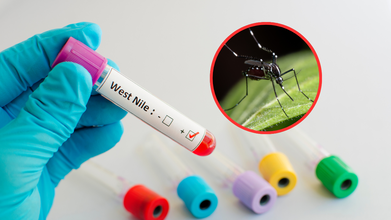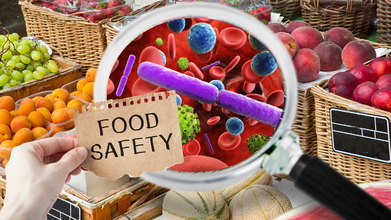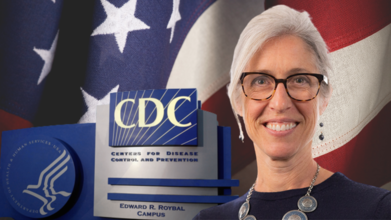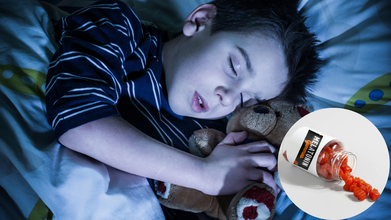- Health Conditions A-Z
- Health & Wellness
- Nutrition
- Fitness
- Health News
- Ayurveda
- Videos
- Medicine A-Z
- Parenting
- Web Stories
Health Officials Confirm First West Nile Death In Colorado – Can You Get It More Than Once?

(Credit-Canva)
A Fort Collins resident has died from neuroinvasive West Nile virus, as reported by the Larimer County Department of Health and Environment on August 25. This marks the first West Nile virus death in the county this season.
“We are saddened by this loss and extend our deepest condolences to this resident’s loved ones,” said Tom Gonzales, Larimer County's public health director. “This death underscores the potentially serious nature of West Nile virus.”
There have been 20 confirmed cases in the county this season, affecting people from ages 24 to 86. Statewide, there are 69 confirmed cases, with 28 resulting in hospitalization and 28 showing neurological symptoms.
West Nile virus is spread to people through the bite of an infected mosquito. Most people who are bitten by an infected mosquito will have no symptoms or a mild illness, similar to the flu. Less than 1% of people who are infected get a more severe illness that causes inflammation of the brain (encephalitis) or the tissues around the brain (meningitis). Symptoms usually appear within one to two weeks. There is no specific cure for the illness, only supportive care.
West Nile Virus: Why Is There A Sudden Spike in Cases Across US?
Infection rates in mosquitoes in west Fort Collins are 4.5 times higher than normal, according to an August 19 memo to the Fort Collins City Council. The city has sprayed to kill mosquitoes at least seven times this summer because the infection rate in mosquitoes has been high.
The Minnesota Department of Health (MDH) has reported 20 cases of West Nile virus so far in 2025, with two of the infected people having died. The number of cases can change from year to year depending on factors like heat and rainfall. Because of the recent increase, health officials are urging people to be careful.
"This is a high-risk time of year for West Nile virus," said Elizabeth Schiffman, supervisor of MDH's Vectorborne Diseases Unit. "It's important to prevent mosquito bites when people are enjoying time outside while the weather is still nice. That's the best way to avoid getting West Nile virus."
Even with cooler weather and fewer mosquitoes, the virus is still active. Gonzales urges everyone to "take precautions" because "trap data still show that mosquitoes in Larimer County are carrying the virus.”

Is There A Test To Detect West Nile Virus?
According to the Centre of Disease Control and Prevention (CDC) West Nile virus is usually diagnosed by testing blood or spinal fluid for specific antibodies, which are proteins the body makes to fight the virus. These tests look for WNV-specific IgM antibodies, which are a key sign of a recent infection.
In some cases, further testing is needed to confirm the diagnosis. A special test called the plaque-reduction neutralization test (PRNT) can help identify the exact virus causing the infection.
Can West Nile Be Cured?
Most people who get infected with West Nile virus will not show any symptoms. In fact, about 80% of people won't feel sick at all.
Also Read: Israeli Scientists Created The First Lab-Grown Kidney That Survived 34 Weeks
For those who do get sick, symptoms usually appear 2 to 14 days after being bitten by an infected mosquito. Symptoms can take longer to appear in people with a weakened immune system.
There is no specific treatment for West Nile virus. For a mild illness, managing symptoms at home with over-the-counter medicine and rest is often enough. For a severe illness, patients are usually hospitalized for supportive care, such as IV fluids and pain medication.
Can You Get West Nile More Than Once?
According to South Dakota Department of Health, healthcare professional believe that it is possible to get West Nile virus more than once, but it is highly unlikely.
After a person is infected with West Nile virus, the body develops immunity to the specific strain of the virus that caused the infection. This immunity is generally believed to be long-lasting, providing protection against future infections from the same strain.
However, there are different strains of West Nile virus, and it's theoretically possible to be infected with a different strain. Additionally, a person's immune response can vary, and some people may have a weaker or less lasting immunity than others. For example, people with weakened immune systems may not develop strong, long-lasting immunity after their first infection.
While re-infection is a possibility, the risk is extremely low. Most people who have had West Nile virus are considered to be protected from future infections. The most important prevention measure is to continue protecting yourself from mosquito bites.
CDC Subtly Pulls Back On Food Safety Surveillance Programs; Will This Make Outbreaks Harder To Track?

Credits: Health and me
For nearly three decades, the Foodborne Diseases Active Surveillance Network—better known as FoodNet—has been a cornerstone of food safety monitoring in the United States. Established in the 1990s, the system actively tracked laboratory-confirmed cases of foodborne infections across 10 states, covering more than 50 million Americans. It was widely regarded as the most reliable source of data on how foodborne pathogens affect people in real time.
But in July, the Centers for Disease Control and Prevention (CDC) made a dramatic change that caught even public health experts off guard. FoodNet, which once monitored eight of the most common foodborne pathogens, will now actively track only two: Salmonella and Shiga toxin-producing E. coli (STEC). Monitoring of the other six pathogens—Campylobacter, Cyclospora, Listeria, Shigella, Vibrio, and Yersinia—has been cut from the system’s required surveillance.
The CDC has defended the move as a resource-driven necessity, but food safety officials warn the implications could be far-reaching.
What the CDC Isn’t Tracking Foodborne Illnesses Anymore?
The CDC has stated that the decision was rooted in funding limitations. In a memo shared with the Connecticut Department of Health, the agency wrote: “Funding has not kept pace with the resources required to maintain the continuation of FoodNet surveillance for all eight pathogens.”
CDC spokesperson Paul Prince echoed this sentiment in a statement, narrowing surveillance would allow FoodNet staff “to prioritize core activities” and “steward resources effectively.”
The backdrop of the decision is years of budgetary tightening. Under the Trump administration, the CDC and other federal agencies faced significant cuts, with the CDC losing hundreds of employees in a single year. While the agency still maintains other surveillance programs—including the National Notifiable Diseases Surveillance System and the Listeria Initiative—those systems are passive. Unlike FoodNet, which actively gathered case information from hospitals and laboratories, passive systems depend on health departments voluntarily reporting infections.
FoodNet was unique in its reach and approach. Operating in 10 states—Colorado, Connecticut, Georgia, Maryland, Minnesota, New Mexico, Oregon, Tennessee, and select counties in California and New York—the program didn’t simply count cases. It collected detailed data about each infection, including patient demographics, hospitalization rates, and outcomes. This level of detail allowed scientists to track trends, spot outbreaks early, and identify which foods posed the greatest risks.
With six pathogens now off the mandatory list, experts worry the CDC is losing its clearest lens into the country’s food safety picture.
“FoodNet doesn’t just count cases,” explained Carlota Medus, who supervises the Minnesota Department of Health’s foodborne diseases unit. “The FoodNet sites collect robust data that contribute to the understanding of certain infections. Without that, we’ll miss trends and lose the ability to compare data over time.”
Other Pathogens That May Go Unnoticed
Salmonella and STEC are among the leading causes of severe foodborne illness, accounting for significant numbers of hospitalizations and deaths each year. But the other six pathogens removed from FoodNet’s core surveillance aren’t minor players.
- Campylobacter is one of the most common bacterial causes of diarrhea worldwide.
- Listeria is especially dangerous for pregnant women, newborns, and immunocompromised individuals, often leading to life-threatening infections.
- Cyclospora has been behind large outbreaks linked to imported produce.
- Vibrio infections are increasingly common as warming waters fuel bacterial growth in seafood.
- Shigella and Yersinia also cause serious illness, particularly in children.
By removing active surveillance of these pathogens, public health agencies may not immediately detect upticks in infections—or worse, may not realize when an outbreak is underway until it spreads widely.
What Are The Risks of Passive Food Safety Monitoring?
Foodborne infections are legally reportable in the U.S., but passive reporting systems depend heavily on overwhelmed local health departments. Without the active case-finding that FoodNet provided, some infections may never be logged.
This shift doesn’t just risk slower outbreak detection; it also undermines years of carefully built datasets. Tracking trends over time requires consistency. If monitoring drops for certain pathogens, comparing future case numbers to historical data becomes nearly impossible.
Medus warned that “long term, it will affect our ability to use surveillance data to better understand risks in the food supply.” That data, she noted, has historically been critical in shaping both state and federal food safety policies.
The White House has insisted that food safety remains a top priority. A spokesperson for the administration said in a statement: “The health and safety of the American people is the Administration’s utmost priority. USDA, HHS, FDA, and the CDC will continue to cooperate and maintain the highest vigilance to safeguard our food supply against pathogens.”
Still, the quiet rollout of the change with no public announcement until uncovered by NBC News—has left many food safety experts uneasy. Transparency is key in public health, and the perception of cuts without clear communication erodes public trust.
How Consumers Can Protect Themselves Despite the Cutbacks?
For the average consumer, the change won’t alter day-to-day food safety advice. Washing produce, cooking meat to safe temperatures, avoiding unpasteurized dairy, and practicing good kitchen hygiene remain the best defenses against foodborne illness.
But behind the scenes, fewer eyes on potential threats may mean outbreaks are detected later and policy shifts are slower to emerge. The U.S. already sees an estimated 48 million cases of foodborne illness each year, leading to 128,000 hospitalizations and 3,000 deaths, according to the CDC. Without robust surveillance, those numbers could be harder to track—or worse, to reduce.
What This Means for Food Safety Policy?
The cut to FoodNet highlights a deeper issue, foodborne illness surveillance is underfunded despite being essential. Experts argue that instead of scaling back, the U.S. should be expanding monitoring to capture new and emerging pathogens, especially as globalization and climate change reshape the food supply.
For now, FoodNet’s infrastructure remains intact, and states are free to continue monitoring other pathogens on their own if they have the resources. But state health departments often rely on federal funding to support surveillance staff. Without it, few will be able to maintain the same level of vigilance.
'RFK Is Weaponizing Public Health': White House Sacks US CDC Director Susan Monarez Amid Vaccine Cuts

(Credit-2024 World Medical Innovation forum/CDC)
The White House has fired the director of the US Centers for Disease Control and Prevention (CDC), Susan Monarez. The White House stated that Monarez was "not aligned with the president's agenda." Her firing has created a lot of controversy. Monarez's lawyers quickly responded, saying she was not told about her removal and would not quit her job. They accused Health Secretary Robert F. Kennedy Jr. of targeting her because she refused to approve "unscientific, reckless directives." They also claimed Kennedy was "weaponizing public health."
Monarez is a scientist who specializes in infectious disease research. President Donald Trump nominated her, and she was confirmed by the Senate in July. She was the first CDC director in 50 years to not have a medical degree
What Are The New COVID-19 Vaccine Guidelines?
On the same day Monarez was fired, the Food and Drug Administration (FDA) approved new COVID-19 vaccines but with strict rules about who can get them. The vaccines will be available for all seniors, but not for younger adults and children who do not have other health problems. Health Secretary Kennedy commented on this, saying that the broad vaccine rules from the previous administration have now been "rescinded," or taken back.
Monarez's firing is just one part of the problems at the CDC. Earlier this month, a union for CDC employees announced that about 600 workers had been fired. The people who lost their jobs worked on important topics like infectious diseases and environmental hazards. In addition, Monarez had recently been comforting staff after a gunman, who believed he was harmed by COVID-19 vaccines, attacked the CDC headquarters and killed a police officer.
Will COVID Vaccines Come To An End?
There have also been reports that the Trump administration might get rid of COVID-19 vaccines completely. Health Secretary Kennedy, who is well-known for being skeptical of vaccines, has already made a big move by pulling $500 million in federal funding from 22 projects that were developing new mRNA vaccines. He said these vaccines don't work well against respiratory infections. However, medical experts say his claims are false and that his actions could make people lose trust in science.
HHS has also announced a big change in how it invests in vaccine research. The department is moving away from funding mRNA vaccine projects and is instead focusing on what it calls "alternative" vaccine technologies. This shift has drawn criticism from scientists who say that mRNA technology was crucial to the rapid COVID-19 response and is a vital tool for fighting future pandemics.
Another major change was when Kennedy got rid of every member of the Advisory Committee on Immunization Practices (ACIP). This group had been advising the CDC for decades. Kennedy replaced them with a small, hand-picked group, claiming the old members had conflicts of interest. These changes have made many medical professionals confused and concerned. Some clinics and pharmacies are now unsure whether to offer certain vaccines to pregnant women or healthy children, and they don't know if insurance will cover them. While older people and those with health problems can still get vaccines, access has become less clear for healthy children and adults.
Popular Sleep Aid Suspended After Gummies Triggered Kids 'Overdosing' On Melatonin

Credits: Canva
A major online health retailer has suspended sales of melatonin products to Australia after a surge in overdose reports, raising alarm about the widespread and often unregulated use of the hormone as a sleep aid for children.
US-founded iHerb, which delivers supplements and health products to more than 180 countries, abruptly pulled melatonin from its Australian marketplace. The move has left many parents in shock, particularly those who have long relied on the company to sidestep prescription-only rules in Australia.
For years, families have quietly ordered melatonin from overseas to help children with ADHD, autism spectrum disorder, or chronic sleep problems. Many never consulted a doctor, trusting online reviews or anecdotal reassurance instead.
Melatonin Gummies: Parents Divided Between Panic and Relief
For some families, iHerb’s decision feels like a lifeline suddenly cut off. One mother, posting in a support group for parents of neurodivergent children, admitted: “I know a lot of us purchase melatonin from iHerb for our ADHD/ASD kiddos. It’s now been banned due to it being a prescription medicine.”
Another confessed the impact was immediate: “My kids won’t sleep without it.”
But the suspension has also sparked relief among others who fear melatonin has become dangerously normalized. One parent commented, “Honestly, I think this is a good thing. My son is autistic and I use it for him so I understand some children really do need it – but it’s also very overused, and look at all the overdoses from it this year.”
This divide reflects a broader tension in child health: the desperate search for effective solutions versus the risks of self-managing with little medical oversight.
A Surge in Poisonings Raises Red Flags
The catalyst for iHerb’s decision appears to be stark new data out of Western Australia. Calls to the state’s Poisons Information Centre about melatonin overdoses have jumped 166 percent in the past five years, with nearly 90 percent involving children.
In 2018, the hotline logged 175 calls. By August this year, that number had soared to 322.
The majority of cases involve children accidentally consuming too many melatonin gummies. Symptoms reported included stomach pain, dizziness, excessive drowsiness, and headaches. Though rarely fatal, repeated overdoses underscore how the supplement’s candy-like form and lack of dosage regulation put children at risk.
The rise of melatonin gummies has reshaped how parents approach sleep issues. Marketed as natural, gentle aids, they blur the boundary between dietary supplement and pharmaceutical.
Some products even fail to disclose melatonin on their packaging, presenting them instead as magnesium or herbal-based sleep support. Investigations have revealed discrepancies in labeling, with some gummies containing significant levels of melatonin despite being marketed differently.
This grey zone is particularly troubling because, in Australia, melatonin is legally restricted. It is classified as a Schedule 4 prescription-only medicine, available to adults over 55 for short-term insomnia or to travelers for jet lag. For children, it may be prescribed in specific clinical cases, but under strict medical guidance. The online marketplace bypassed all of that until now.
A spokesperson for iHerb told the Daily Mail, “The health and well-being of our customers always comes first. That’s why we are suspending all melatonin sales to Australian customers while we further review our order protocols for these products. Our goal is to support wellness responsibly and to give our customers confidence that they can shop with safety and trust.”
The company has not provided a timeline for when or if sales might resume. Dr. Kyle Hoath of the Australian Medical Association’s Western Australian branch welcomed the suspension. “It’s good to see that iHerb has taken a proactive step,” he said. “The problem is that, when you think about the way an online retailer like iHerb works, there’s no interaction with a pharmacist. It’s the consumer choosing what they want without any guidance around what is safe.”
The move highlights how online platforms can fill regulatory gaps but also create new ones, enabling mass importation of products that would otherwise face strict scrutiny.
While Australia is grappling with the risks of imported melatonin, other countries face similar challenges. In the United States, melatonin is widely available as an over-the-counter supplement, with minimal regulation compared to pharmaceuticals. Usage has skyrocketed among children and teenagers, prompting pediatricians to raise alarms about potential long-term impacts on hormone development and circadian rhythms.
In the UK, melatonin is also tightly controlled, available only by prescription. Yet similar concerns about misleading labeling and accidental overdoses in children have emerged there too. This patchwork of rules creates opportunities for cross-border loopholes—like Australian parents ordering through iHerb that complicate public health responses.
For parents who depended on melatonin, the suspension may feel devastating. But health experts stress that the bigger issue isn’t the lack of access—it’s the lack of medical oversight.
Children’s sleep problems can stem from many causes: neurological conditions, behavioral habits, environmental triggers, or emotional stressors. While melatonin may help in certain cases, it is not a one-size-fits-all solution. Without guidance from a pediatrician, families risk masking deeper issues or creating new ones.
The iHerb suspension is not just a supply chain hiccup it’s a wake-up call about the need for safe, evidence-based care.
How Can Parents Build A Better Bedtime Sleep Routine Without Dependence on Melatonin?
Parents anxious about losing melatonin as an option can take heart: natural, structured approaches to sleep often prove more effective long-term than supplements.
Creating a reliable bedtime routine is one of the most powerful tools. Children thrive on predictability, and a consistent wind-down ritual teaches the brain when it’s time to rest. This can start with dimming lights an hour before bedtime, turning off screens, and engaging in calming activities such as reading together, listening to soft music, or practicing gentle breathing.
Sleep hygiene also extends to the environment. A cool, dark, quiet room signals to the body that it’s time to sleep. White noise machines or soft nightlights can help reduce anxiety, especially for children who struggle with sensory sensitivities.
Parents should pay attention to diet and activity as well. Limiting caffeine and sugar in the afternoon, ensuring children get plenty of daylight exposure and exercise, and timing dinner a few hours before bed can significantly improve sleep readiness.
Perhaps most importantly, bedtime should not feel like a punishment. When framed as a positive, nurturing routine—one that involves connection rather than control children are more likely to settle into it willingly.
While melatonin may play a role for some children under medical supervision, it cannot replace the emotional security and consistency that a healthy routine provides. For families suddenly cut off from supplements, this may be the right moment to reset and rebuild sleep in a sustainable, safe way.
© 2024 Bennett, Coleman & Company Limited

